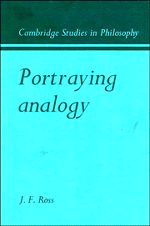Book contents
- Frontmatter
- Contents
- Dedication
- Preface
- Introduction
- 1 The limitations of classical analogy theory and the Miller's Analogies transition
- 2 The genus: meaning differentiation
- 3 Predicate schemes: an explanatory model
- 4 Equivocation, analogy and metaphor
- 5 Denominative analogy and paronymy
- 6 Figurative discourse
- 7 Analogy and religious discourse: craftbound discourse
- 8 Analogy and analysis
- Notes
- Bibliography
- Name index
- Subject index
6 - Figurative discourse
Published online by Cambridge University Press: 07 October 2011
- Frontmatter
- Contents
- Dedication
- Preface
- Introduction
- 1 The limitations of classical analogy theory and the Miller's Analogies transition
- 2 The genus: meaning differentiation
- 3 Predicate schemes: an explanatory model
- 4 Equivocation, analogy and metaphor
- 5 Denominative analogy and paronymy
- 6 Figurative discourse
- 7 Analogy and religious discourse: craftbound discourse
- 8 Analogy and analysis
- Notes
- Bibliography
- Name index
- Subject index
Summary
THE HYPOTHESIS:
HYPOTHETICAL CONSTRUCTION
The meanings of salient words in figurative discourse can be hypothetically constructed as a shortest sequence of step wise adaptations from typical same words in nonfigurative discourse. The steps of differentiation are those already explained: proportionality, metaphor, denomination and paronymy.
The ‘double differentiation’ cases that involve both metaphor and analogy (or paronymy) are characteristic of figurative discourse. They are its semantic signature.
‘To be used figuratively’ and ‘figurative occurrence’ have three different senses in various contexts that follow. A word is said to be used figuratively, (1) if its being used in a certain way is constitutive of some classical figure of speech, e.g. ‘governed’ in ‘He governed himself and his province’, to create zeugma; (2) denominatively, for every word constitutive in some figure of speech (e.g. alliteration) and (3) the technical usage developed in this chapter for ‘occurring figuratively’, ‘is a figurative occurrence’ and the like: a word occurs figuratively just in case it occurs constitutively in figurative or heightened (as identified by likeness to paradigms in poetry and literature) discourse and its shortest path of hypothetical construction (by meaning adaptation) from a typical, not-merely-equivocal same word outside figurative discourse involves both analogy (or paronymy) and metaphor.
Hypothetical construction is successive domination that generates one sense from another. Different frame-expressions, that do not cause mere equivocation, successively differentiate a word from non-figurative discourse (in a typical occurrence) until an occurrence univocal with the figurative occurrence has been generated.
- Type
- Chapter
- Information
- Portraying Analogy , pp. 142 - 157Publisher: Cambridge University PressPrint publication year: 1982



